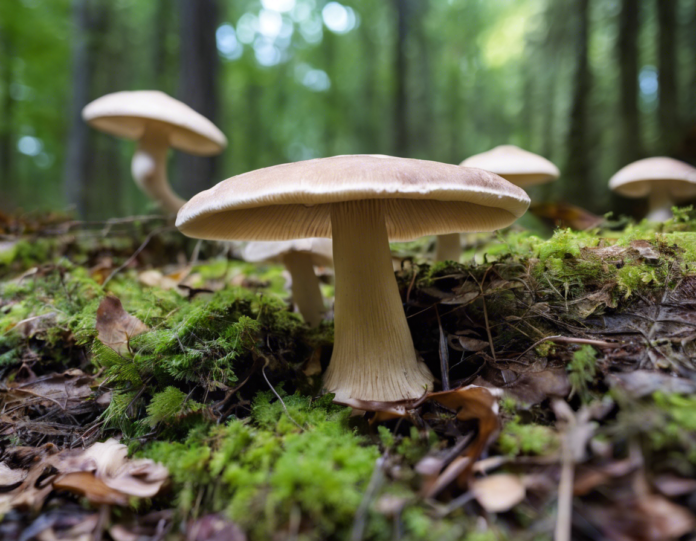Have you ever come across a mushroom that looks like a flying saucer in the woods? Well, you may have encountered what is known as the UFO or flying saucer mushroom! This unique and interesting mushroom, scientifically classified as Peziza domiciliana, is a fascinating sight for any nature enthusiast or mycology aficionado.
What is the Flying Saucer Mushroom?
The flying saucer mushroom earned its name due to its peculiar shape, which resembles a UFO or a saucer. It belongs to the genus Peziza, which is known for its cup-shaped mushrooms. The unique appearance of this fungus sets it apart from the typical cap-and-stem structure of many other mushrooms. When fully grown, the flying saucer mushroom can measure anywhere from 1 to 5 inches in diameter, with a concave center and a wavy edge that gives it a distinct saucer-like appearance. Its color can range from pale beige to a darker brown or grey, depending on its maturity.
Habitat and Distribution
The flying saucer mushroom is a saprophytic fungus, meaning it feeds on decaying organic matter. You can often find it growing on rotten logs, mulch, compost piles, or other decaying plant material. It prefers moist and shady environments, thriving in the cool and damp conditions typically found on forest floors. While it is not uncommon to spot the flying saucer mushroom in the wild, it is generally less abundant compared to other more common mushroom species.
Life Cycle and Reproduction
Like many fungi, the flying saucer mushroom reproduces through the release of spores. As the mushroom matures, it develops spore-containing structures on its surface. When these spores are released into the environment, they can be carried by the wind to new locations where they can germinate and start new colonies. The life cycle of the flying saucer mushroom is crucial for its survival and dispersal, allowing it to colonize new habitats and continue its growth and propagation.
Edibility and Culinary Use
While the flying saucer mushroom is not known to be toxic, it is not commonly consumed due to its tough and rubbery texture. Additionally, its small size and scarcity in the wild make it impractical for culinary purposes. Foraging for wild mushrooms carries risks, as misidentification of species can lead to poisoning. Therefore, it is always recommended to exercise caution and consult with an experienced mycologist before consuming any wild mushrooms, including the flying saucer mushroom.
Cultural Significance and Folklore
Mushrooms have held a special place in human culture and folklore for centuries, often featuring in myths, stories, and even rituals. The unique appearance of the flying saucer mushroom has captured the imagination of many, leading to its inclusion in various cultural references and depictions. In some traditions, mushrooms are associated with mystical properties or even extraterrestrial origins, adding to the allure of unusual species like the flying saucer mushroom.
Conservation and Protection
As with many fungi and wild mushrooms, the flying saucer mushroom faces threats from habitat loss, climate change, and human activities. Conservation efforts aimed at preserving forest ecosystems and biodiversity are essential for protecting species like the flying saucer mushroom and ensuring their continued existence in the wild. Educating the public about the importance of fungi in ecosystems can also help raise awareness about the need to conserve these fascinating and often overlooked organisms.
Fun Facts about the Flying Saucer Mushroom:
- The flying saucer mushroom is also known by other names such as the flying saucer cup or UFO fungus.
- Some species of Peziza mushrooms are used in traditional Chinese medicine for their purported medicinal properties.
- The saucer-like shape of the flying saucer mushroom serves a functional purpose, helping to protect its spores and aid in dispersal.
Frequently Asked Questions (FAQs):
1. Can I eat the flying saucer mushroom?
While the flying saucer mushroom is not known to be toxic, it is not recommended for consumption due to its tough texture and limited culinary appeal.
2. Where can I find the flying saucer mushroom?
You can often find the flying saucer mushroom growing on decaying logs, mulch, or compost piles in shady and moist environments such as forests.
3. Is the flying saucer mushroom rare?
While not considered rare, the flying saucer mushroom is less abundant compared to more common mushroom species, making it a unique find for mushroom enthusiasts.
4. What is the scientific name of the flying saucer mushroom?
The flying saucer mushroom belongs to the species Peziza domiciliana.
5. Can I cultivate the flying saucer mushroom at home?
While it is possible to cultivate certain species of Peziza mushrooms indoors, the flying saucer mushroom is not commonly cultivated due to its specific habitat requirements.
In conclusion, the flying saucer mushroom is a fascinating and unusual species of fungus that adds to the diversity and intrigue of the natural world. Its saucer-like shape, unique habitat preferences, and life cycle make it a captivating subject for observation and study. By learning more about mushrooms like the flying saucer mushroom, we can gain a greater appreciation for the intricacies of the fungal kingdom and the vital role these organisms play in ecosystem functioning.

